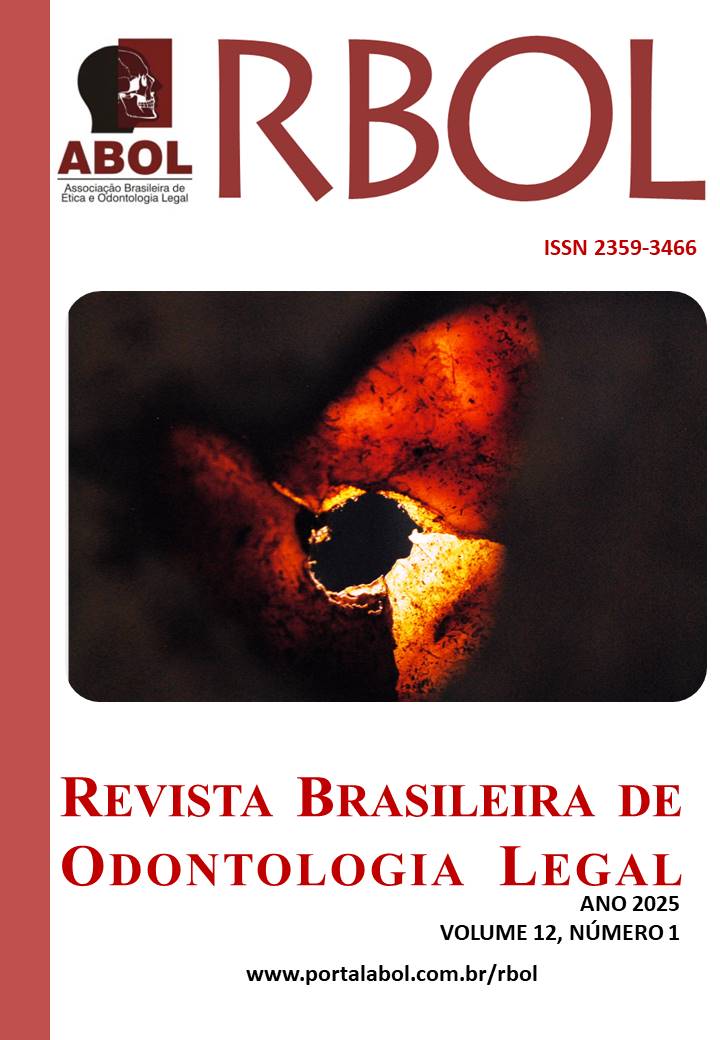APPLICABILITY OF PALATAL RUGOSCOPY CODIFICATION AS A TOOL IN HUMAN IDENTIFICATION
DOI:
https://doi.org/10.21117/rbol-v12n12025-615Palavras-chave:
Antropologia Forense, Odontologia Legal, Palato duroResumo
Forensic dentistry is one of the areas of science that places the knowledge of dentistry in favor of civil society and justice. One of the great efficiencies of this specialization is the human identification, where rugoscopy is an efficient biological method. This technique involves the study of palatine wrinkles that are unique anatomical accidents and that are present in strategic locations in the anterior portion of the hard palate, being considered immutable throughout life and, consequently, being important in the study of human identification. The objective of this work was to study the rugoscopic characteristics of individuals from the city of Feira de Santana, in order to assess its applicability as a method of individual human identification. An observational, classificatory and cross-sectional study was performed. The study corresponded to the analysis of 100 plaster casts of the upper arch, where 51 corresponded to females and 49 to males. Regarding the analyses, it was decided to adopt the classifications of Silva (1936), analyzing the quantitative relation of wrinkles; Carrea (1937), relating the arrangement of wrinkles; and Bassauri (1961), analyzing the morphotypes of wrinkles. The results showed that, according to Silva’s system, each individual has approximately 11 wrinkles. As for Carrea’s analysis, type IV was the most predominant. While Bassauri showed no agreement on any pattern. Finally, it was found that there are no significant differences, proving that rugoscopy can be used as an effective means for human identification, in addition to being a feasible, low-cost and easy-to-perform method
Downloads
Publicado
Edição
Seção
Licença
Os autores deverão encaminhar por email, devidamente assinada pelos autores ou pelo autor responsável pelo trabalho, a declaração de responsabilidade e transferência de direitos autorais para a RBOL, conforme modelo abaixo.
DECLARAÇÃO DE RESPONSABILIDADE E TRANSFERÊNCIA DE DIREITOS AUTORAIS
Eu (Nós), listar os nomes completos dos autores, transfiro(rimos) todos os direitos autorais do artigo intitulado: colocar o título à Revista Brasileira de Odontologia Legal - RBOL.
Declaro(amos) que o trabalho mencionado é original, não é resultante de plágio, que não foi publicado e não está sendo considerado para publicação em outra revista, quer seja no formato impresso ou no eletrônico.
Declaro(amos) que o presente trabalho não apresenta conflitos de interesse pessoais, empresariais ou governamentais que poderiam comprometer a obtenção e divulgação dos resultados bem como a discussão e conclusão do estudo.
Declaro(amos) que o presente trabalho foi totalmente custeado por seus autores. Em caso de financiamento, identificar qual a empresa, governo ou agência financiadora.
Local, data, mês e ano.
Nome e assinatura do autor responsável (ou de todos os autores).

